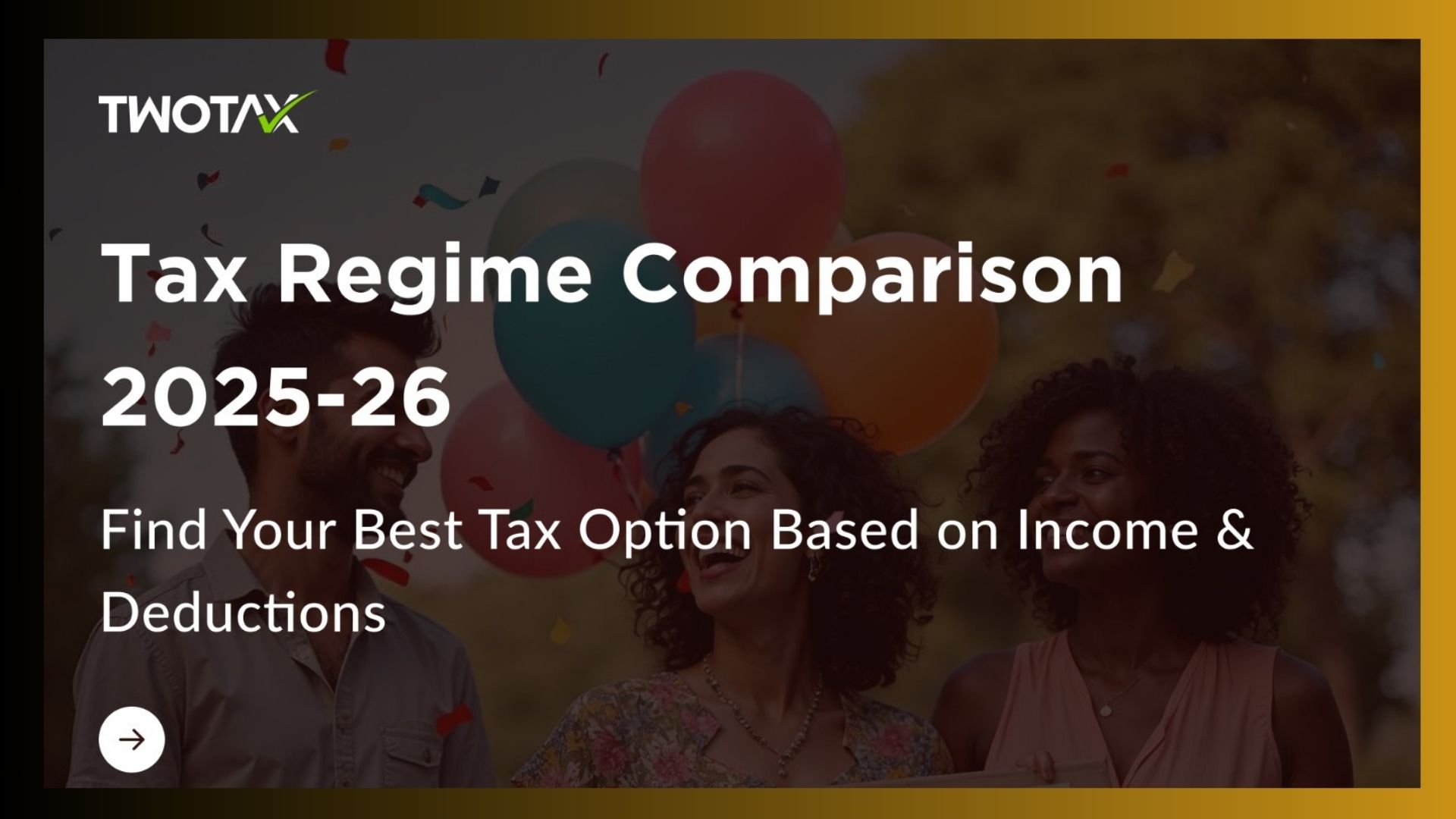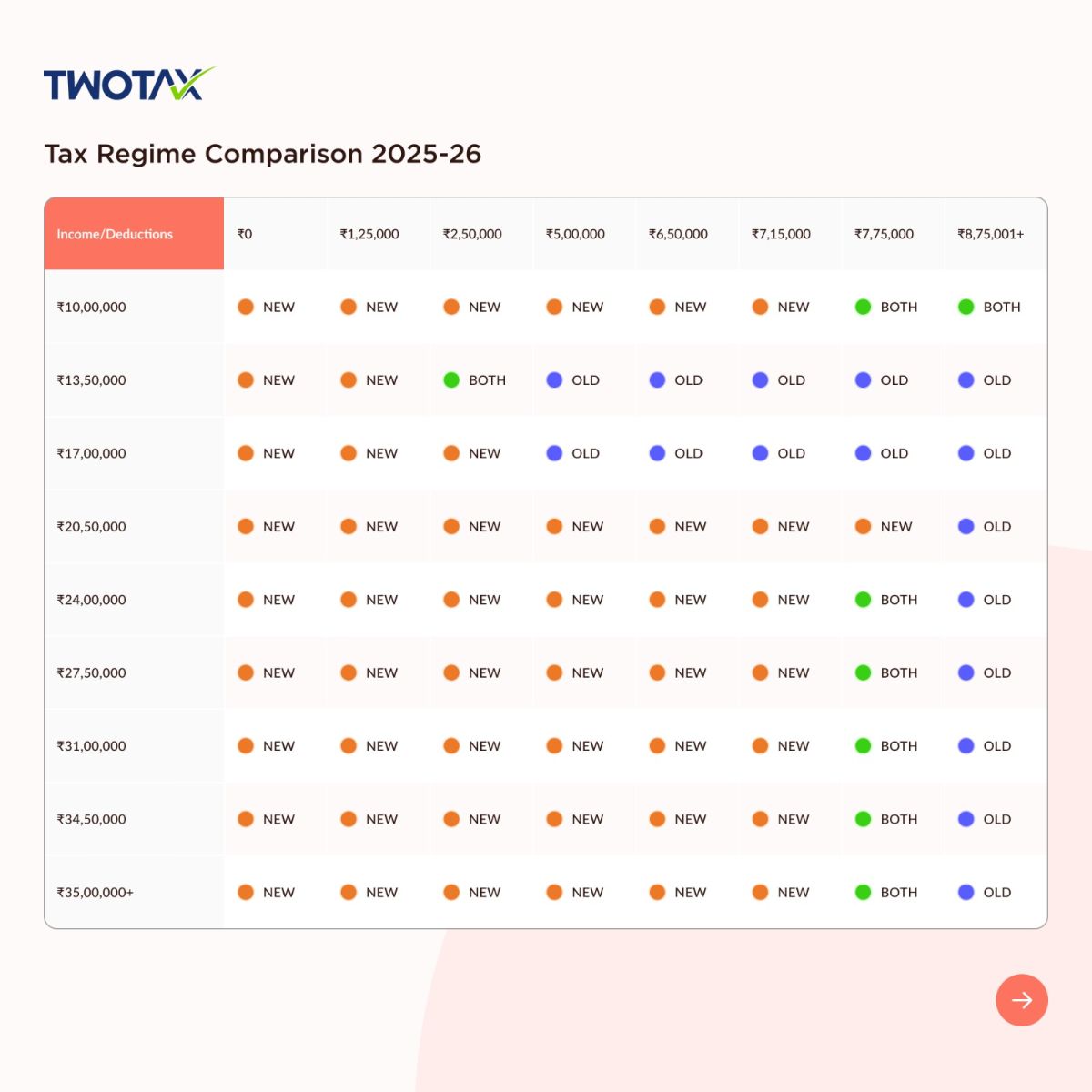Connect with us for all your queries



Before delving into the specifics of the 2025-26 comparison, it's essential to understand the fundamental differences between the two tax regimes.

Section 80C: Deductions for investments in instruments like EPF, PPF, LIC, etc., up to ₹1.5 lakh.
House Rent Allowance (HRA): Exemption for rent paid, subject to certain conditions.
Leave Travel Allowance (LTA): Exemption for travel expenses incurred during leave.
Section 80D: Deduction for health insurance premiums.
Section 24: Deduction for interest paid on home loans.
The provided image presents a comparison of the two tax regimes for the assessment year 2025-26 across different income brackets. Let's analyze the data:Lower Income Brackets (Up to ₹7,15,000):
For individuals with income up to ₹7,15,000, the new tax regime appears to be more beneficial.
Even with deductions of ₹2,50,000, the new regime still seems preferable.
At this income level, it might be beneficial to calculate taxes under both regimes to see which one is more advantageous.
For individuals with income exceeding ₹8,75,001, the old tax regime is generally more beneficial.
Impact of Deductions: The turning point where the old tax regime becomes more beneficial is heavily influenced by the amount of deductions a taxpayer can claim. The higher the deductions, the more likely it is that the old regime will result in lower tax liability.
Simplification vs. Tax Savings: The new tax regime simplifies tax filing by eliminating the need to track and claim various deductions. However, this simplicity might come at the cost of higher tax outgo, especially for those who can claim significant deductions under the old regime.
Varying Preferences: The "BOTH" option suggests that at certain income levels and deduction amounts, the tax liability under both regimes might be very close, making the choice dependent on individual preferences for simplicity versus potential tax savings.
Several factors should be considered when deciding between the new and old tax regimes:
Amount of Deductions: Calculate the total value of deductions and exemptions you can claim under the old tax regime. If this amount is substantial, the old regime is likely to be more beneficial.
Availability of Deductions: Ensure that you actually have the necessary investments and expenses to claim the deductions. Don't choose the old regime based on potential deductions that you might not be able to utilize.
Lower Income: For lower-income individuals, the new tax regime might be simpler and more beneficial due to its lower tax rates.
Higher Income: For higher-income individuals, the old tax regime can be more advantageous if they can claim significant deductions.
Investments: Plan your investments in such a way that you can maximize deductions under the old tax regime if you choose to opt for it.
Expenses: Keep track of eligible expenses like rent, medical insurance premiums, and home loan interest to claim deductions.
Ease of Filing: If you prefer a simpler tax filing process without the hassle of tracking deductions, the new tax regime might be a better option, even if it results in slightly higher tax liability.
Long-Term Investments: If you have long-term financial goals that align with investment options that qualify for deductions under Section 80C, the old regime might be more suitable.
To illustrate the decision-making process, let's consider a few scenarios:
Scenario 1: Income ₹10,00,000, Deductions ₹0
New Tax Regime: Recommended, as there are no deductions to claim.
Old Tax Regime: Not beneficial, as the absence of deductions would result in a higher tax liability.
Scenario 2: Income ₹13,50,000, Deductions ₹2,50,000
New Tax Regime: Might be preferable.
Old Tax Regime: This is the turning point where the old tax regime starts becoming advantageous. With deductions of ₹2,50,000, the taxable income reduces to ₹11,00,000, which might result in lower tax liability under the old regime.
Scenario 3: Income ₹20,50,000, Deductions ₹5,00,000
New Tax Regime: Not recommended.
Old Tax Regime: Highly beneficial. Reducing the taxable income to ₹15,50,000 with ₹5,00,000 in deductions would likely result in significantly lower tax under the old regime.
Scenario 4: Income ₹35,00,000+, Deductions ₹7,75,000
New Tax Regime: Not recommended.
Old Tax Regime: The clear choice. With high income and substantial deductions, the old regime would offer considerable tax savings.
Tax laws and regulations are subject to change based on government policies and fiscal requirements. It's essential to stay updated on any amendments or changes to the tax regimes that might impact your tax planning. For example:
Changes in Tax Rates: The government may revise the tax rates under both regimes, which could alter the attractiveness of each option.
Modifications to Deductions: Any changes to the eligibility criteria or limits for deductions under the old tax regime can significantly affect its viability.
Introduction of New Taxes or Cess: The imposition of new taxes or cess could also influence the overall tax liability under each regime.
Choosing between the new and old tax regimes for the assessment year 2025-26 requires careful consideration of various factors, including income level, deductions, tax planning, and individual preferences. The new tax regime offers simplicity and lower tax rates, while the old tax regime provides opportunities for tax savings through deductions and exemptions.
Based on the table, the new tax regime appears more beneficial for individuals with lower income and limited deductions. However, as income and deductions increase, the old tax regime becomes more attractive.
Tax Partner is India’s most reliable online business service platform, dedicated to helping you in starting, growing, & flourishing your business with our wide array of expert services at a very affordable cost.